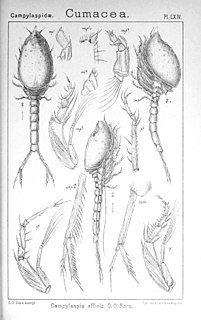
Northern krill, Meganyctiphanes norvegica, is a species of krill that lives in the North Atlantic Ocean. It is an important component of the zooplankton, providing food for whales, fish and birds. M. norvegica is the only species recognised in the genus Meganyctiphanes, although it has been known by several synonyms:

Mysidae is the largest family of crustaceans in the order Mysida, with over 1000 species in around 170 genera.
Tenagomysis is a genus of mysid shrimps in the family Mysidae, containing the following species:

Diastylis is a genus of crustaceans which belong to the family Diastylidae. It includes the following species:

Diastylidae is one of the eight most commonly recognised families of crustaceans of the order Cumacea. They are marine creatures especially common around the 30th parallel north.

Bodotriidae is a family of crustaceans belonging to the order Cumacea. Bodotriids have a worldwide distribution in shallow and deep waters. There are over 380 described species in over 30 genera, being the most diverse cumacean family. Their external morphology differs from other cumaceans by a combination of traits that independently are not unique to the family: the telson is fused to the last abdominal segment, the dorsal part of the mandible has a boat shape (naviculoid), exopods exist on the third maxilliped and the first peraeopod, and there is a uropodal endopod with one or two articles.

Nannastacidae is a family of crustaceans belonging to the order Cumacea. They have no free telson. The endopods of the uropods are present on one segment. There are exopods on the maxillipeds and generally one on pereopods 1–4 in males and 1–2 in females. In the females the second antenna is much shorter than the first. It contains the following genera:
Clausiidae is a family of parasitic copepods of the suborder Poecilostomatoida, comprising the following genera:

Eurydice is a genus of isopod crustaceans named after the mythical Eurydice, wife of the musician Orpheus. It includes the following species:

Paramysis is a genus of mysid crustaceans (Mysidacea) in family Mysidae, distributed in coastal zone of low boreal East Atlantic Ocean, Mediterranean Sea and the basins of Black Sea, Sea of Azov and Caspian Sea.

Acanthomysis is a genus of mysids, containing 28 species.
Nannastacus is a genus of crustaceans in the order Cumacea. It contains the following species:

Oenopota is a genus of sea snails, marine gastropod mollusks in the family Mangeliidae.

Bela is a genus of sea snails; marine gastropod mollusks in the family Mangeliidae.

Praunus is a genus of mysid shrimp, comprising three species:

Campylaspis is a genus of crustaceans in the order Cumacea. Species of Campylaspis have a "bulky" carapace, which makes up more than 40% of the animal's length, as well as distinctive features of the mouthparts. There are currently 170 recognised described species:
Mihai Băcescu was a Romanian zoologist.
Mysidopsis is a genus of mysid shrimps in the family Mysidae. The sensitivity of these shrimps to water quality makes them suitable for bioassays. Mysidopsis bahia and Mysidopsis almyra, which are used frequently to test for pesticides and other toxic substances, are now classified as Americamysis bahia and Americamysis almyra.
Erythrops elegans is a species of crustaceans in the family Mysidae. It is found in the northeastern Atlantic Ocean and in the Mediterranean Sea.











